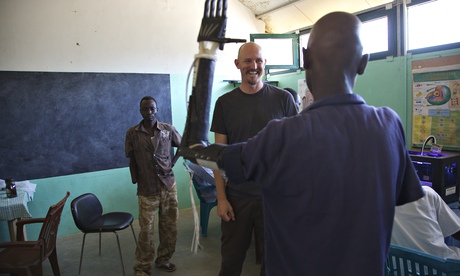
In November 2013 Mick Ebeling left his home in Venice Beach, California for the Nuba Mountains in Sudan. His aim? To meet a young double amputee named Daniel Omar and print him a prosthetic arm.
Since then, Project Daniel has been covered by much of the world's media, so when we caught up with the entrepreneur, we were keen to know what impact the innovation is having in Sudan and how Ebeling's background in advertising is informing his efforts to use 'technology for the sake of humanity'.
What motivated you to travel to Sudan?
We come from the school of open source that believes that devices like this should be readily available to everybody. We taught a group of eight young men to continue doing the work and we left a big box of filament and supplies and two 3D printers.
It took me about four days to get back from Sudan, and when I got home I looked at my email and had pictures of two arms that were made while we were in the air. Obviously, Daniel feeding himself for the first time in two years was an incredible success, but seeing that this was sustainable, that was the most exciting.
How durable are the limbs?
They actually are quite durable. But because they're modular – you print out the knuckle, finger and palm separately – if something breaks, you just print it again. With an expensive prosthetic when something breaks you have to send it back to the manufacturer. And there's no post in the Nuba Mountains. That's one of the reasons why this solution is so great, something can break and you're not precious about.
What's the funding model of your organisation, Not Impossible? I read that you started off as a foundation but now you're for profit working with big brands in an innovative way
We started off Not Impossible as a non-profit and I joked that I was going deaf by the sound of the rattling of the tin cups. As a non-profit you are limited by the whims and trends in giving. I didn't want to be governed by trends, I wanted to be governed by what we wanted to accomplish.
I transfered my experience as a commercial producer working with advertising agencies. My belief is the more people that know about the stories that we've created, the more chance it's going to get implemented. We realised that if we get in touch with the most powerful entities in the world – brands and corporations – and work with what they already do – create messages around their brands – we can help each other.
How does that work in practice?
We partner with brands who have products and goods and services that make sense with our initiative. Intel and Precipart were two brands that came in to underwrite Project Daniel. In return they got content. They got a webfilm that they were able to take out and promote. They were looking for stories to tell. Instead of an advert about the attributes of the product, they got a powerful message. The brand wins because they get acknowledged for supporting something good. We're just fitting into a branding and messaging system that already exists within the corporate world, that ethically and organically fulfills what we want.
Are there any corporations you wouldn't work with?
We're not old enough yet to experience any ethical crossroads of what to do or not to do, but we want to work with companies who want to do good in the world.
Do you think your project provides any lessons for other development organisations?
A lot of the NGOs over there are doing great work and a lot of them are bogged down by the bureaucracy of a huge organisation. If you can implement anything that overcomes that then you're already ahead of the game. Our goal is for people to be inspired by the open source mentality of empowering and equipping people to help themselves. 3D printing puts the power into the hands of the people on the ground. Once you educate people on what a particular thing can do, they will always make it do something more.
What's the next challenge you are tackling?
We're looking at taking 3D printers to Nicaragua, Vietnam, Cambodia, Colombia, Sierra Leone – places that reached out to us. And we're working on a project right now in Mexico that's going to help kids with cerebral palsy, muscular dystrophy or multiple sclerosis to walk again.
Correction: this piece was amended on Monday 16 June to change South Sudan to Sudan.
Read more stories like this:
• Marketing: still the dirty word of development?
• Top tips on using the media to aid development
• DIY biotech: how to build yourself a low-cost malaria detector
Join the community of global development professionals and experts. Become a GDPN member to get more stories like this direct to your inbox

